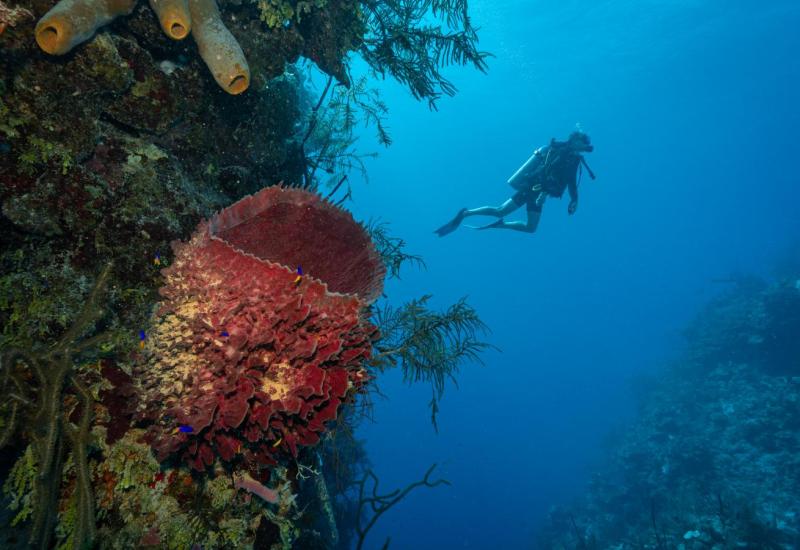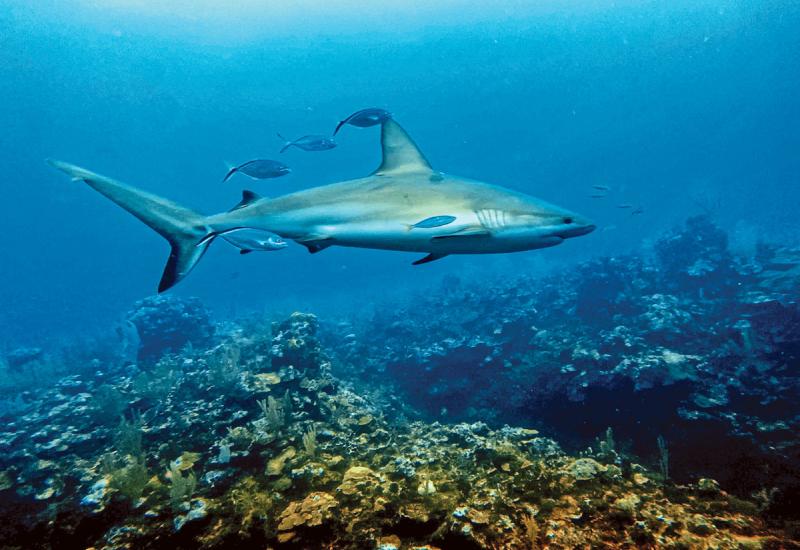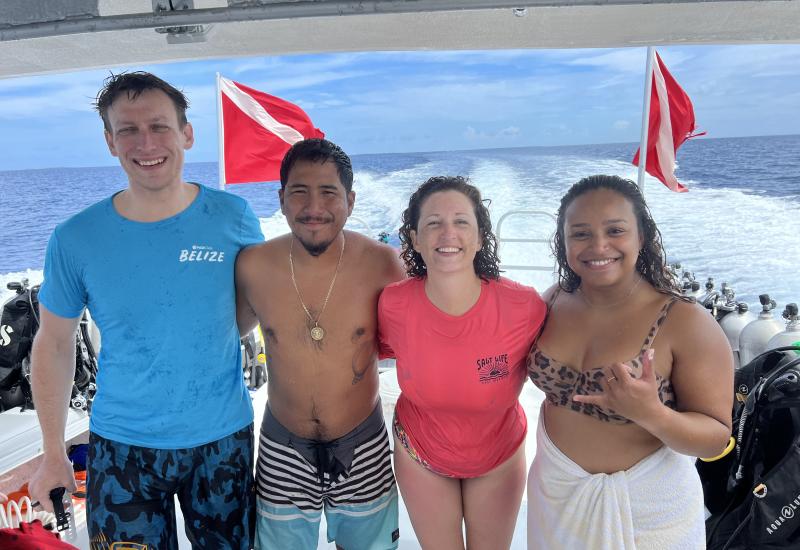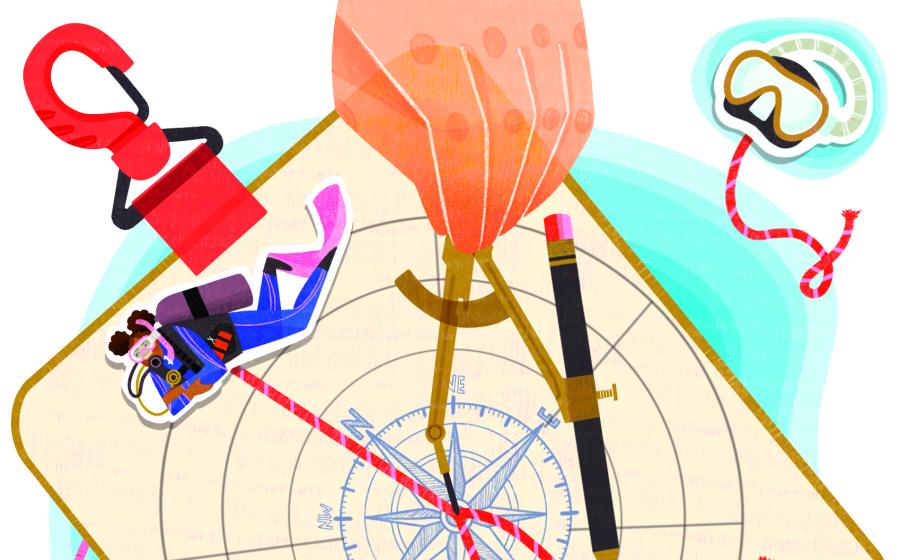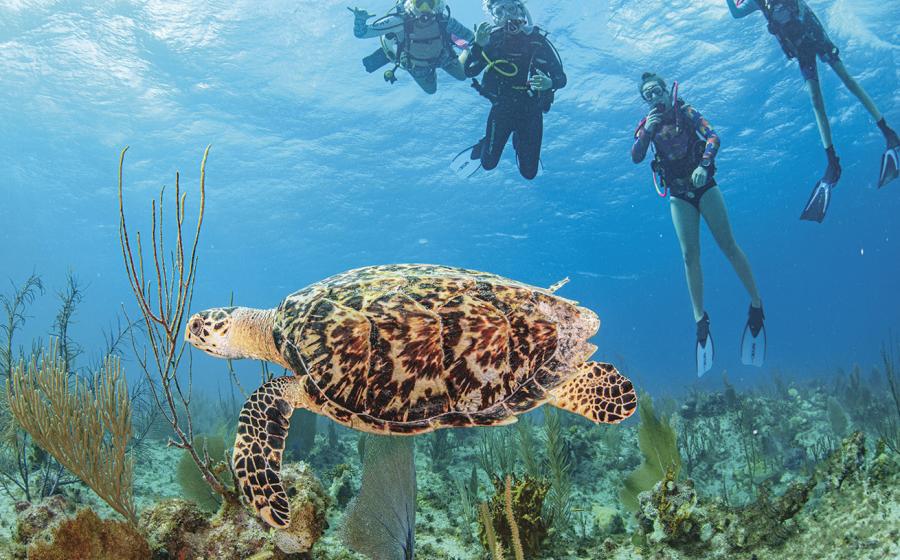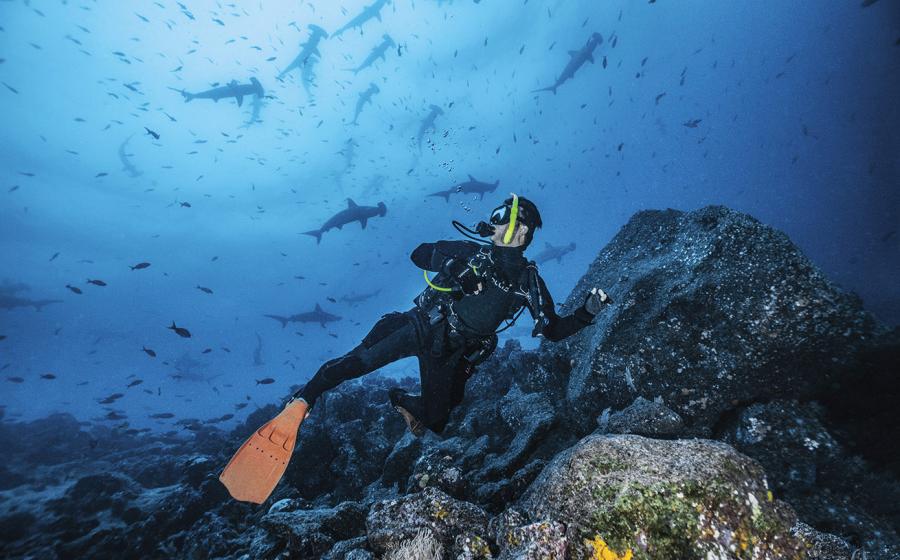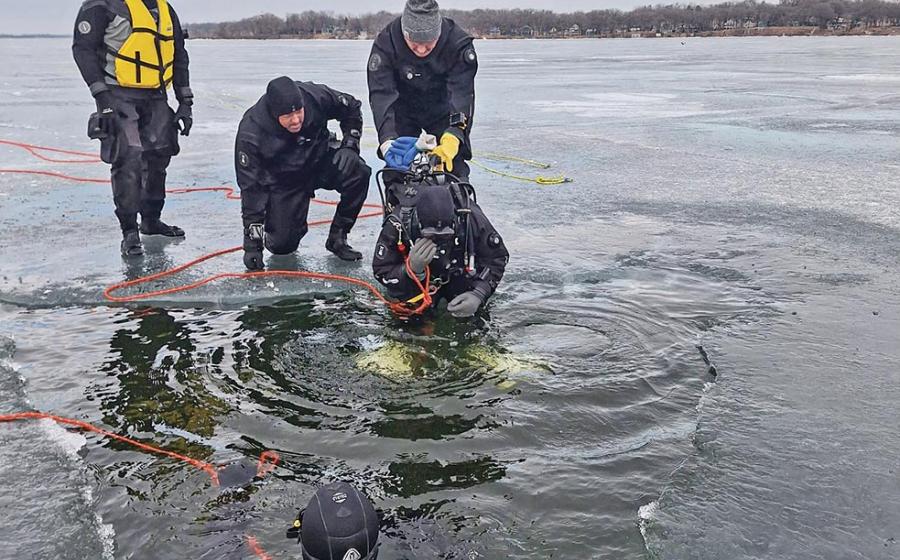Element of Surprise - Belize
Alex Edwards told me the turtle story my first evening on Spanish Lookout Caye, the two of us seated beneath a Belizean sky flooded with stars, the tide working its way about the dock pilings beneath us, making a sound like a child stirring quietly in a tub. Alex was born in Belize City, home to slightly less than a third of the country's 290,000 residents. Like most Belizeans, Alex is a born storyteller, his prowess accentuated by a charming brashness. "Dis is how it worked, man," said Alex, watching the sky as he spoke. "It was the last day of Lent. When we were kids our parents always used to tell us not to go in the water on the last day of Lent because they believed that's when the most accidents happened. So I'm divin' out at Lighthouse Reef and I see this big turtle comin' and he's gettin' bigger and bigger. I'm pointin', pointin', pointin' and suddenly I'm thinking 'He's not stoppin'; he's going to smack right into me.' Big turtle. Could have done some damage." Alex windmilled his arms slowly, dropping his head back to perform a seated limbo.
"Man, I had to make one of those Matrix moves. This huge loggerhead turtle, his head was bigger than mine, he passes right over the top of me. Yes, man. Everyone wanted to know how I slipped that turtle." Alex Edwards told me the turtle story my first evening on Spanish Lookout Caye, the two of us seated beneath a Belizean sky flooded with stars, the tide working its way about the dock pilings beneath us, making a sound like a child stirring quietly in a tub. Alex was born in Belize City, home to slightly less than a third of the country's 290,000 residents. Like most Belizeans, Alex is a born storyteller, his prowess accentuated by a charming brashness. "Dis is how it worked, man," said Alex, watching the sky as he spoke. "It was the last day of Lent. When we were kids our parents always used to tell us not to go in the water on the last day of Lent because they believed that's when the most accidents happened. So I'm divin' out at Lighthouse Reef and I see this big turtle comin' and he's gettin' bigger and bigger. I'm pointin', pointin', pointin' and suddenly I'm thinking 'He's not stoppin'; he's going to smack right into me.' Big turtle. Could have done some damage." Alex windmilled his arms slowly,dropping his head back to perform a seated limbo.
Had Alex been cold-cocked by the loggerhead, I had no doubt he'd have been out diving on the next Good Friday as well. I had long heard tales of Belize, an exotic and mysterious realm tucked between Mexico and Guatemala, home to migrating whale sharks, jaguars, jungle pyramids and caves housing the skeletal remains of ancient sacrifice. And now to that list I could add kamikaze turtles. Rainforests! Tapirs! Jaguars! Guidebooks on Belize practically crowed its praises in my hands. Was there ever a realm more mysterious? If this didn't cry out for investigation, what did?
Alex's head was still tilted back at a severe angle. I followed his gaze. Above us the night sky was suddenly laced with the fiery trail of a shooting star.
A PLETHORA OF ATOLLS Divers are familiar with the pertinent details: Belize is home to three of the Americas' four atolls (Glover's Reef Atoll, Lighthouse Reef Atoll and Turneffe Atoll), and the world's second-longest barrier reef (185 miles). As if all this weren't enough, Turneffe Atoll is also home to the 410-foot divot that is the Blue Hole. The world's largest sinkhole, renowned even among non-divers as a blue orb staring unblinking into space, the Blue Hole is an icon for Belize that has turned the production of Blue Hole turista knickknacks into a thriving cottage industry. As an added convenience, Belize is close to home, both literally and figuratively. A two and a half hour hop from Houston places you in the only Central American country where English is the official language.
For the diver, Belize has one other happy convenience mile upon mile of reef, with plenty of dive spots you've never heard of, most of them within eyeshot of one of some 200 cays off the coast. Thus one might enjoy a cocktail on the porch with a clear view of waves unfolding upon the reef and the enticing scent of mystery below. I spent nine days diving in Belize, first off Spanish Lookout Caye, then heading north to Blackbird Caye and Ambergris Caye. With only a few exceptions, we were at each dive site in 10 minutes at most. Was I happy? Jesse James couldn't have beenhappier living inside a bank vault.
Twenty-five minutes by boat from Belize City, Spanish Lookout Caye is home to the Belize Adventure Lodge, a collection of colorful cottages and additional accoutrements (restaurant, dive shop) facing the Caribbean Sea. Spanish Lookout Caye offers convenient access to the myriad reefs and walls of Turneffe Atoll, largest of Belize's three atolls. I dove sites fat with yawping goldentail morays and enormous Caribbean spiny lobsters and pugnacious groupers, with silkily swaying sea fans as a backdrop. When I wasn't diving, I walked to the cay's back end where Agnieszka Obara, a bright and affable Aussie, oversees Belize's first dolphin encounter and labors alongside her fellow trainers to promote marine awareness. Aggie and the other trainers are friendly and always find time to talk, despite the steady influx of sun-crisped cruise-shippers arriving to experience their encounter with the program's four Atlantic bottlenose dolphins. I learned many fascinating things about dolphins, including the fact that they sleep with half their brain functioning, proof, in my mind, that in slumber the marine mammals share close kinship with certain members of our own species.
Life was everywhere.
One morning Alex was waiting at my door. Without preamble, he motioned to the light green waters just off the wooden walkway.
"We have a fish, very strange, you see right here in the mangroves," he said."They're here most mornings."
Alex and I both squinted hard at a lump resembling a rock. It was a rock.
Alex shrugged.
"You see the batfish here all the time," he said.
I had read that batfish were rare. When I told Alex this, he shrugged again.
"They say they are rare, but I find them a lot out here."
On Alex's say-so, during my three days on the island, I made a game of looking for batfish. By the time I left I had spotted a dozen, the majority of them from the boardwalk leading to my cottage. And so, regarding Belize, I immediately unearthed a critical lesson. Yes, guidebooks lavish heaping praise upon Belize's natural wonders. But surprisingly, they still sell them short.
On Blackbird Caye, at the Blackbird Caye Resort on the eastern side of Turneffe Atoll, I fell in with a playful group of divers from Syracuse, New York. I liked the Syracuse divers. They had spunk and knew a good thing when they saw it. Thirty-two miles from Belize City, Blackbird Caye is everything you imagine in a tropical paradise: luxurious cabanas, a white sand shore, a blue-green lagoon spilling out to the reef, plus volleyball every afternoon at four. Each morning the sun would extricate itself from the deep blue sea, while overhead frigate birds, like dark kites, soared in the slowly lightening sky and the palms clicked in an already steady breeze. This delicate aesthetic maintained itself 24 hours a day, from stunning sunrise to equivalent sunset and on into night, cotton candy clouds piling their silvery way toward the moon. As one of the Syracusans aptly put it, "I don't think there's a bad view on the whole island."
The only drawback: no swimming at night. And there was a reason: After sunset the cay's waters belonged to the resident saltwater crocodile. I made numerous trips to the dock at the back of the island where he reportedly lolled, but I had no luck encountering the mysterious creature.
Bob, a member of the Syracuse clan, had seen him.
"He's right near the dock," Bob said. "During the day?" I asked. Bob's eyebrows arched slightly. "I'm not going back there at night."
So Bob and I contented ourselves with the smaller denizens of the sea. Again, the nearby reef offered myriad dives, many of them a "blink and you're the last one in the water" boat ride from the resort dock. Clambering into the boat, our butts would only just touch fiberglass and our dive guides brothers James and Cardinal Andrews would inform us, "Okay guys, two minutes to the dive site."
On our very first dive, at a spot called Little Calabash a lovely hobbit forest of corals a whopping five minutes from the dock James found a white spotted toadfish. Sanopus astrifer is unique to Belize. After my fellows had snapped their requisite photos and finned off, I descended to the small crevice. The toadfish, a grumpy-looking thing, stared balefully back at me before performing an underwater chuff that sent up a small cloud of sand. Later, James explained. "They're pretty smart fish," he said. "As soon as they see us, they blow the sand up so you can't see them."
This didn't stop James and Cardinal from finding numerous toadfish, as well as day-glo indigo hamlets and enormous channel-clinging crabs tucked like mossy, thick-legged spiders into shadowy recesses. We saw sea turtles too, hawksbills mostly, turning as easily as leaves in the wind, and spotted eagle rays, their wings rippling as if passing through a spectrum of breezes. Camera extended, Bob finned after one of the rays, a futile exercise that I nonetheless understood. After all, a child chases sea gulls by the water's edge, even though the cause is hopeless, for the joy of the chase and the tangible taste of faint possibility.
James and Cardinal also shared a boyish enthusiasm for Belize's underwater world. James dove with an easy smile and a bandana emblazoned with the Belizean flag wrapped around his head. Hovering over him I read the credo, Sub Umbra Floreo: "Under the shade tree we flourish." The valuable mahogany tree brought foreign domination, but Belize has been independent of British rule since 1981. Occupation aside, Belize holds an enviable track record sadly lacking on today's world stage: a history free of civil war. Mestizos (Spanish-Maya), Creoles (African-European), Mayas, Garinagus and Mennonite chicken farmers have coexisted in a state of relative amicability. A distinguished-looking gentleman I metin Belize City explained it best. "It is too small a neighborhood for serious fights," he said.
On my second day at Blackbird Caye, we dove the Elbow. This actually required a 45-minute boat ride scrolling past palm-lined cays Soldier, Calabash, Deadman's, Coco Tree most of them little more than scuff marks on the surface of the Caribbean Sea. The Elbow is a must-dive in Belize, a 3,000-foot wall whose currents are known for bringing in schools of grunts, permit, jack and snapper, not to mention hawksbills, loggerheads, eagle rays and the occasional hammerhead. I have always liked wall dives finning over the edge of a reef into fall-away blue never fails to produce a Peter Pan sensation of flight and the Elbow is a fine wall. There were barrel sponges the size of cannibal vats and gorgonians splayed like the root systems of upended trees, except roots aren't festooned with tiny fish, bright yellow, orange, purple and blue. Above the reef, schools of Atlantic spadefish and yellowtail snapper reflected the sun.
That night after dinner, my fellow divers stumbled sleepily back to their cabanas, but I had one more item on my wish list. I walked back to the dock in the mangroves. The croc was gone, possibly out trolling for disobedient skinny dippers, but I stayed on the dock a long time. The absolute darkness of the mangroves was reassuring, serving to accentuate the shooting stars overhead.
BRIGHT LIGHTS, BIG CITY Ambergris Caye is the wildest and largest of Belize's cays. Whalers named the cay after the precious substance taken from sperm whales, and the cay's southern end, with the town of San Pedro, hops as lively as any whaling port of call. Dusty and bustling, San Pedro has ATMs, water taxis (running until 2 a.m.), humming golf carts (in deference to the narrow streets), air-conditioned supermarkets and uniformed school children so accustomed to tourists that they accord them the ultimate tribute, ignoring them entirely. You can buy Colombian emeralds or $2 tamales (at Antojito Letty's Tamales), rent Jet Skis and kayaks, buy Blue Hole knickknacks, or quaff a coconut rum and pineapple juice Panty Ripper (don't ask) while enjoying the patois of English, Spanish, Creole and Maya echoing about you.
I prefer quiet to city noise, but I liked San Pedro. It exuded the same brashness and lack of pretension I had come to admire in Belize's citizenry. Bumping along the sandy streets on a bicycle, I passed the Hungry Monkey Sub Shop, its sign proclaiming its product "The Best Sub in Central America." I spied a girl of about 10 swinging a Coke bottle on the end of a string. The bottle was filled with sand, possibly to give it the additional momentum it needed to escape the half-dozen barefoot urchins chasing it around and around. When I stopped to tell her I admired her ingenuity, she fixed me with a direct gaze while her cohorts fidgeted impatiently. "I invented this game," she said. I thought of Alex and remembered his words that night under the stars. " I am proud to be Belizean."
REVERENCE IN THE HOLE I stayed some four miles north of San Pedro, at Journey's End Resort, so named because it was once the northernmost tourist outpost. No more. Resorts, condos and restaurants scrolled northward, and where there weren't buildings already in place, the rebar skeletons of posh new developments rose, trumpeting paradise and promise.
Fortunately Journey's End came with a dive operation free of inane fanfare. Belize Ocean Divers and head instructor Steve Bowen run a sleepy but effective operation, with their small weathered headquarters fronted by ascattering of rattan chairs perfect for serious lounging.
Ambergris Caye offers access to hundreds of dives, named and unnamed, and Steve's dive guides took me to more than my share. We dove Mexico Rocks, one of the few places in Belize to find pipefish, Renegade Canyon with its fun Disney-style swim-throughs, Happy Hour Reef, Sandy Point and Angel Flats, where I watched a hawksbill rise, a leathery Icarus, toward the sun.
I also watched a steady stream of divers demand to dive the Blue Hole. Steve had little patience for these divers, many of whom seemed to view the sinkhole more as a running of the bulls than as a rare and special experience. Steve flexed an appreciable bicep. "Everyone wants to do the Blue Hole, man," he said.
Well, I did too, and so we left the Journey's End dock before sunrise on a black and breezy morning. Jacques Cousteau declared the Blue Hole one of the planet's must-dives, yet I had also heard the sinkhole maligned for its lack of sea life. But the Blue Hole isn't about fish; it's about something far bigger, and I was surprised by the sinkhole's effect on me. We descended, falling past the coral slope that ended at 45 feet, down, down, down along the sheer wall. Several blacktip sharks drifted on our periphery. The blue water assumed shadows, and then became a shadow; it squeezed gently, its clasp like encouragement. Come. See.
At 130 feet, the famed stalactites, tucked inside a cavern, don't so much appear as leap out at you. Just as suddenly, you are aware of your place. Up to 40 feet long and six feet thick, the stalactites are more like temple pillars, an apt analogy because they radiate a sense of something far beyond us. Formed drip by drip as rainwater seeped through porous limestone, they place time, and man, in proper perspective. Cousteau understood, though this is only a guess as his fleeting time has already passed. Entering the cavern, I was overwhelmed with a surprisingly powerful feeling of deference. We finned between the stalactites, a brief and viscous Stonehenge maze, and then the dive was over, although the memory swims eternally in my mind.
On my final day in Belize I dove Ambergris Caye's famed Hol Chan Marine Reserve. As we approached, the scene was not encouraging. With boats everywhere, great packs of pink-backed snorkelers rode atop colorful floaties, shouting and thrashing in the water. A woman on our boat read my mind.
"I don't like this," she grumbled. Ours proved a snotty and misguided attitude because beneath the surface there was a riot of life. It didn't matter that at points we were in five feet of water. Once, looking up, I saw a snorkeler directly above me, eyes and belly bulging. He was smiling, and I knew why. The surface may have looked like a crowd scene, but underwater each snorkeler was enjoying his or her own private theater. Barracuda, tarpon and eagle rays made their way through the sand channels; nurse sharks snaked across the sea-grass shallows. Schools of smaller fish massed against the corals, silver, blue and yellow curtains so thick they might have been the reef itself. I spied a green moray swimming free. Before I could give it my full attention, three more rose, like thick streamers, from among the corals.
This was ridiculous. Such abundance. And then I remembered Alex's turtle, the batfish beneath the boardwalk, the lurking invisible crocodile and the Blue Hole's reverential aura. This was glorious. And I remembered the country's topside attractions rainforest, people, history, language setting the stage for stunning mysteries revealed below sea level. Belize was indeed a land of surprise.
Special thanks to Hugh Parkey's Belize Adventure Lodge (belizeadventurelodge.com) and Belize Dive Connection (belizediving.com), the Blackbird Caye Resort (black birdresort.com), and Journey's End Resort (journeysendresort.com) and Belize Ocean Divers (belizeoceandivers.com).
DECO STOPS You'll arrive in Belize City, not the capital (that's Belmopan), but the country's population hub. For a taste of Belize's history and culture, visit the Museum of Belize and take in a show at the Bliss Center for the Performing Arts. For local art, you'll want to visit the Image Factory on Front Street. For Belizean crafts, including mahogany sculptures, visit the National Handicraft Center on South Park. Search local music stores for punta rock, the stew of African percussion, American R & B and Cuban son that you'll hear blaring everywhere. Forty seven percent of Belize's land is protected by government or private trusts, and you should leave town to see some of it. Try for a glimpse of elusive jaguars in the Cockscomb Basin Wildlife Sanctuary (the world's first jaguar preserve) to the south of Dangriga or in the Rio Bravo Conservation and Management Area in northern Belize's Orange Walk province. For wildlife of a more playful sort head to Spanish Lookout Caye, a 25-minute boat ride from Belize City, to see the new Hugh Parkey's Belize Dolphin Experience. Take a water taxi from Belize City to San Pedro on Ambergris Caye. Drop into Barefoot Books for a fine selection of regional reading. Wash down fresh local seafood with an icy cold Belikin beer at Elvi's Kitchen. After a romantic dinner, you and your loved one should find your way to any dock (in Belize they're all public property) to spend some time counting shooting stars.
HONDURASDestination Primer Average Water Temp: : 75°F; low 80s in the summer What to Wear: 3/2 mm shorty ordive skin Average Viz : 100+ feet


